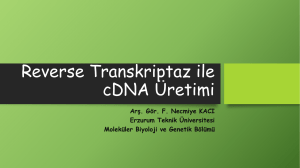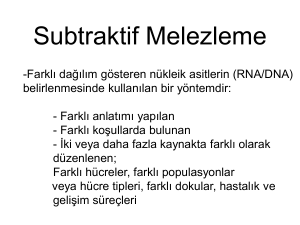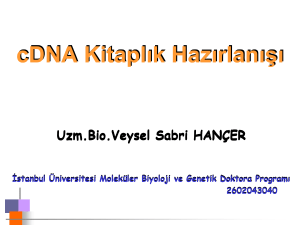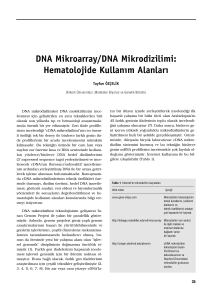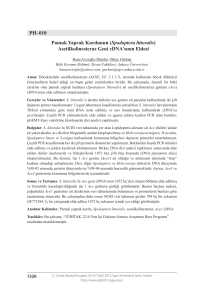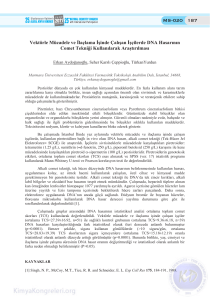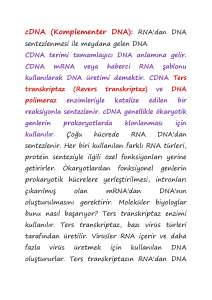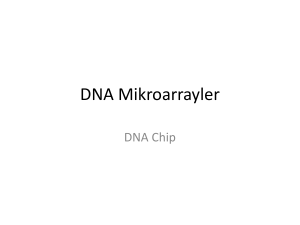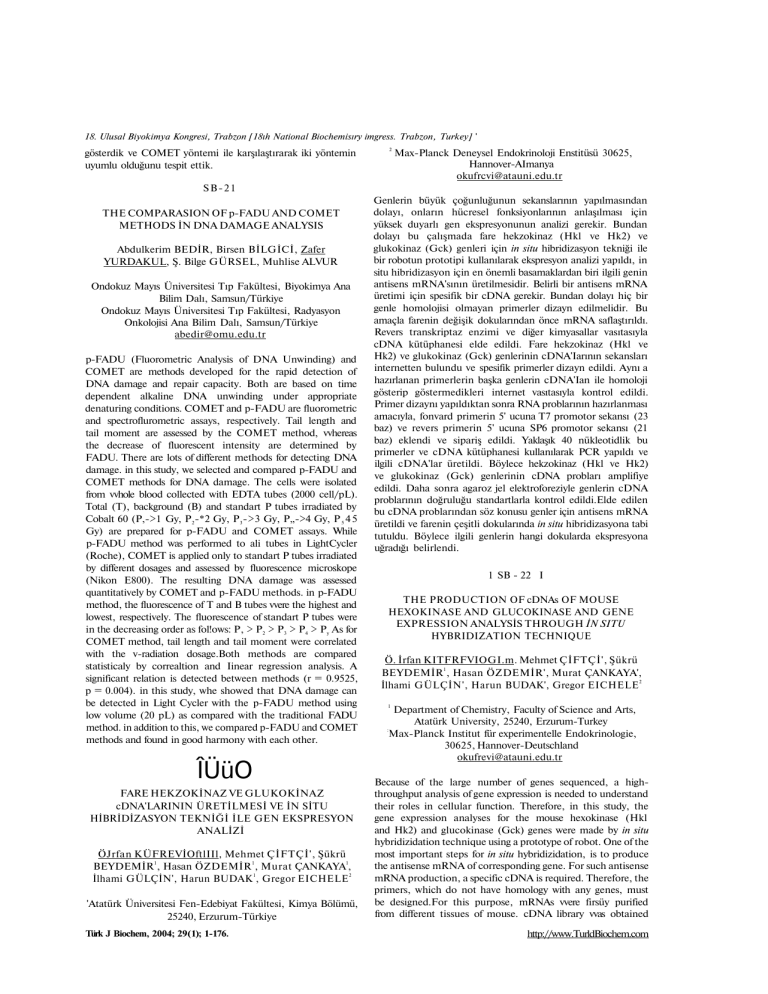
18. Ulusal Biyokimya Kongresi, Trabzon [18ıh National Biochemisıry imgress. Trabzon, Turkey] '
gösterdik ve COMET yöntemi ile karşılaştırarak iki yöntemin
uyumlu olduğunu tespit ettik.
2
Max-Planck Deneysel Endokrinoloji Enstitüsü 30625,
Hannover-AImanya
okufrcvi@atauni.edu.tr
SB-21
THE COMPARASION OF p-FADU AND COMET
METHODS İN DNA DAMAGE ANALYSIS
Abdulkerim BEDİR, Birsen BİLGİCİ, Zafer
YURDAKUL, Ş. Bilge GÜRSEL, Muhlise ALVUR
Ondokuz Mayıs Üniversitesi Tıp Fakültesi, Biyokimya Ana
Bilim Dalı, Samsun/Türkiye
Ondokuz Mayıs Üniversitesi Tıp Fakültesi, Radyasyon
Onkolojisi Ana Bilim Dalı, Samsun/Türkiye
abedir@omu.edu.tr
p-FADU (Fluorometric Analysis of DNA Unwinding) and
COMET are methods developed for the rapid detection of
DNA damage and repair capacity. Both are based on time
dependent alkaline DNA unwinding under appropriate
denaturing conditions. COMET and p-FADU are fluorometric
and spectroflurometric assays, respectively. Tail length and
tail moment are assessed by the COMET method, vvhereas
the decrease of fluorescent intensity are determined by
FADU. There are lots of different methods for detecting DNA
damage. in this study, we selected and compared p-FADU and
COMET methods for DNA damage. The cells were isolated
from vvhole blood collected with EDTA tubes (2000 cell/pL).
Total (T), background (B) and standart P tubes irradiated by
Cobalt 60 (P,->1 Gy, P 2 -*2 Gy, P3->3 Gy, P„->4 Gy, P 5 4 5
Gy) are prepared for p-FADU and COMET assays. While
p-FADU method was performed to ali tubes in LightCycler
(Roche), COMET is applied only to standart P tubes irradiated
by different dosages and assessed by fluorescence microskope
(Nikon E800). The resulting DNA damage was assessed
quantitatively by COMET and p-FADU methods. in p-FADU
method, the fluorescence of T and B tubes vvere the highest and
lowest, respectively. The fluorescence of standart P tubes were
in the decreasing order as fol!ows: P, > P2 > P3 > P4 > Py As for
COMET method, tail length and tail moment were correlated
with the v-radiation dosage.Both methods are compared
statisticaly by correaltion and Iinear regression analysis. A
significant relation is detected between methods (r = 0.9525,
p = 0.004). in this study, whe showed that DNA damage can
be detected in Light Cycler with the p-FADU method using
low volume (20 pL) as compared with the traditional FADU
method. in addition to this, we compared p-FADU and COMET
methods and found in good harmony with each other.
ÎÜüO
FARE HEKZOKİNAZ VE GLUKOKİNAZ
cDNA'LARININ ÜRETİLMESİ VE İN SİTU
HİBRİDİZASYON TEKNİĞİ İLE GEN EKSPRESYON
ANALİZİ
ÖJrfan KÜFREVİOftlIIl, Mehmet ÇİFTÇİ', Şükrü
BEYDEMİR1, Hasan ÖZDEMİR 1 , Murat ÇANKAYA1,
İlhami GÜLÇİN', Harun BUDAK1, Gregor EICHELE 2
'Atatürk Üniversitesi Fen-Edebiyat Fakültesi, Kimya Bölümü,
25240, Erzurum-Türkiye
Türk J Biochem, 2004; 29(1); 1-176.
Genlerin büyük çoğunluğunun sekanslarının yapılmasından
dolayı, onların hücresel fonksiyonlarının anlaşılması için
yüksek duyarlı gen ekspresyonunun analizi gerekir. Bundan
dolayı bu çalışmada fare hekzokinaz (Hkl ve Hk2) ve
glukokinaz (Gck) genleri için in situ hibridizasyon tekniği ile
bir robotun prototipi kullanılarak ekspresyon analizi yapıldı, in
situ hibridizasyon için en önemli basamaklardan biri ilgili genin
antisens mRNA'sının üretilmesidir. Belirli bir antisens mRNA
üretimi için spesifik bir cDNA gerekir. Bundan dolayı hiç bir
genle homolojisi olmayan primerler dizayn edilmelidir. Bu
amaçla farenin değişik dokularından önce mRNA saflaştırıldı.
Revers transkriptaz enzimi ve diğer kimyasallar vasıtasıyla
cDNA kütüphanesi elde edildi. Fare hekzokinaz (Hkl ve
Hk2) ve glukokinaz (Gck) genlerinin cDNA'Iarının sekansları
internetten bulundu ve spesifik primerler dizayn edildi. Aynı a
hazırlanan primerlerin başka genlerin cDNA'Ian ile homoloji
gösterip göstermedikleri internet vasıtasıyla kontrol edildi.
Primer dizaynı yapıldıktan sonra RNA problarının hazırlanması
amacıyla, fonvard primerin 5' ucuna T7 promotor sekansı (23
baz) ve revers primerin 5' ucuna SP6 promotor sekansı (21
baz) eklendi ve sipariş edildi. Yaklaşık 40 nükleotidlik bu
primerler ve cDNA kütüphanesi kullanılarak PCR yapıldı ve
ilgili cDNA'lar üretildi. Böylece hekzokinaz (Hkl ve Hk2)
ve glukokinaz (Gck) genlerinin cDNA probları amplifiye
edildi. Daha sonra agaroz jel elektroforeziyle genlerin cDNA
problarının doğruluğu standartlarla kontrol edildi.Elde edilen
bu cDNA problarından söz konusu genler için antisens mRNA
üretildi ve farenin çeşitli dokularında in situ hibridizasyona tabi
tutuldu. Böylece ilgili genlerin hangi dokularda ekspresyona
uğradığı belirlendi.
1 SB - 22 I
THE PRODUCTION OF cDNAs OF MOUSE
HEXOKINASE AND GLUCOKINASE AND GENE
EXPRESSION ANALYSİS THROUGH İN SITU
HYBRIDIZATION TECHNIQUE
Ö. İrfan KITFRFVIOGI.m. Mehmet ÇİFTÇİ', Şükrü
BEYDEMİR1, Hasan ÖZDEMİR', Murat ÇANKAYA',
İlhami GÜLÇİN', Harun BUDAK', Gregor EICHELE 2
1
Department of Chemistry, Faculty of Science and Arts,
Atatürk University, 25240, Erzurum-Turkey
:
Max-Planck Institut für experimentelle Endokrinologie,
30625, Hannover-Deutschland
okufrevi@atauni.edu.tr
Because of the large number of genes sequenced, a highthroughput analysis of gene expression is needed to understand
their roles in cellular function. Therefore, in this study, the
gene expression analyses for the mouse hexokinase (Hkl
and Hk2) and glucokinase (Gck) genes were made by in situ
hybridizidation technique using a prototype of robot. One of the
most important steps for in situ hybridizidation, is to produce
the antisense mRNA of corresponding gene. For such antisense
mRNA production, a specific cDNA is required. Therefore, the
primers, which do not have homology with any genes, must
be designed.For this purpose, mRNAs vvere firsüy purified
from different tissues of mouse. cDNA library vvas obtained
http://www.TurldBiochem.com
18. Ulusal Biyokimya Kongresi. Trabzon [18ıh National Biochemistry Congress, Trabzon. TurkeyJ
by reverse transcriptase enzyme and other chemicals. cDNAs
sequences of mouse hexokinase and glucokinase genes were
provided with internet and specific primers were designed.
Moreover, if the primers prepared have homology with the
cDNA of other genes was checked through internet. After
primers were designed, T7 promotor sequence (23 base) to 5'
terminal of the fonvard primerand SP6 promotor sequence (21
base) to 5' terminal of the reverse primer were attached and
ordered for the purpose of preparation of RNA probes. PCR
was carried out by these primers of about 40 nucleotides and
cDNA library and cDNAs were produced. Thus, cDNA probes
of hexokinase (Hkl and Hk2) and glucokinase (Gck) genes
were amplified. Then. cDNA probes of corresponding genes
were checked by standards on agarose gel electrophoresis.
Antisense mRNAs were produced from these cDNA probes
of corresponding genes and the antisense mRNAs were used
for in situ hybridization in different tissues of mouse. Finally,
it was determined that which tissue contained expression of
corresponding genes.
SB-23
GST LERİN (GSTMİ, GSTTl, GSTPl) GENETİK
POLIMORFIZMI İLE PRİMER BEYİN TÜMÖRÜ
İNSIDANSI ARASINDAKİ İLİŞKİ.
Hatice PINARBAŞI», Yavuz SİLİĞ", Mustafa GÜRELİK C
Cumhuriyet Üniversitesi Tıp Fakültesi Biyokimya Anabilim
Dalı1,
c
Nöroşirurji Anabilim DaIı ,Fen Edebiyat Fakültesi, Kimya
Bölümü.Biyokimya Anabilim Dalıb,
58140 Sivas. Türkiye.
hpinar@cumhuriyet.edu.tr
Glutatyon S-transferazlar, GSTMİ, GSTTl ve GSTPl,
karsinojenleri de içeren geniş yelpazedeki eksojen bileşiklerin
detoksifıkasyonunda görevli faz II biyotransformasyon
enzimleridir. Kişinin çevresel karsinojenlere olan duyarlılığının
belirlenmesinde bu genlerdeki farklılıkların önemli rol
oynayabileceği tanımlayıcı veanalitikepidemiyoloji çalışmaları
ile gösterilmiştir. Tersini açıklayanlar olsa da bazı çalışmaların
sonuçlan GST enzimlerini kodlayan genlerdeki polimorfızmler
ile bazı kanserler arasında istatistiksel olarak anlamlı bir ilişki
ortaya koymuştur. Bu çalışmada bu genlerdeki polimorfızmler
ile primer beyin tümörü insidansı arasındaki ilişki 228 Türk
bireyde (75 primer beyin tümörü hastası ve 153 kontrol)
incelenmiştir. GSTMİ null genotipin sıklığı hastalarda %43,
kontrollerde %24 ve OR=2.33 (%95 CI= 1.24-4.39) olarak
bulunmuştur. Ne GSTTl ne de GSTPl IlelOSVa! polimorfizmi
ile beyin tümör insidansı arasında bir ilişki gözlenmemiştir.
GSTMİ, GSTTl ve GSTPl in polimorfizmleri ile beyin
tümörünün histopatolojik tipi (glioma veya meninjioma)
arasında bir ilişki saptanamamıştır, incelenen polimorfızmler
ile beyin tümörlü hastaların sigara içme durumları arasında
istatistiksel olarak anlamlı bir ilişki bulunmamıştır. Burada
verilen sonuçlar açıkça GSTTl ve GSTPlgen varyantlarının
değil fakat GSTMİ null genotipin beyin tümörü insidansı
ile ilişkili olabileceğini göstermektedir. Bununla birlikte bu
bulgular daha fazla sayıda bireyi içeren çalışmalar tarafından
doğrulanmalıdır.
Turlc J Biochem. 2004; 29 (1) 1-176.
29
SB-23
GENETIC POLYMORPHISMS OF GSTs (GSTMİ,
GSTTl, GSTPl) AND THE ASSOCIATION VVITH
PRIMARY BRAIN TUMOR INCIDENCE
Hatice PINARBAŞI», Yavuz SILIG", Mustafa GURELIK'
Department of Biochemistry", Neurosurgeryc, Faculty of
Medicine,
Department of Biochemistryb, Faculty of Science and
Art.Cumhuriyet University, 58140 Sivas, Turkey.
hpinar@cumhuriyet.edu.tr
Glutathione S-Transferases, GSTMİ, GSTTl and GSTPl,
are phase II biotransformation enzymes that function on
detoxifıcation of wide range of exogenous agents including
carcinogens. it has been shovvn by descriptive and analytic
epidemiologic studies that genetic variations in these genes play
an important role in determining the response of an individual to
environmental carcinogens. Some studies revealed a statistically
significant association between the polymorphisms in the genes
encoding GST enzymes and some cancers although contrary
reports exist. in this study, association between polymorphisms
in these genes and primary brain tumor incidence was
investigated in 228 Turkish individuals (75 patients with
primary brain tumor and 153 controls). The prevalence of
GSTMİ null genotype in the case group was 437c, compared to
24% in the control group gi ving an odds ratio (OR) of 2.33 (95%
CI= 1.24-4.39). it was observed that neither GSTT1 nor GSTPl
Ilel05Val polymorphism was associated with brain tumor
incidence. Polymorphisms in GSTMİ, GSTTl and GSTPl did
not shovv association with histopathologic type of brain tumor
(glioma or meningioma). Analysis of the polymorphisms in the
studied genes and smoking status of the brain tumor patients
revealed no statistically significant association. Presented data
clearly suggest a relation betvveen brain tumor incidence vvith
GSTMİ null genotype but not with GSTTl or GSTPl gene
variants. However this finding needs to be confırmed by the
studies vvith larger number of study subjects.
SB-24
ERZURUM BÖLGESİNDE GLUKOZ-6-FOSFAT
DEHİDROGENAZ ENZİM EKSİKLİĞİ TESPİT
EDİLEN ŞAHISLARDA MUTASYON İÇEREN
EKZONLARIN BELİRLENMESİ VE BAZI
İLAÇLARIN ENZİM AKTİVİTESİ ÜZERİNE
ETKİLERİNİN İNCELENMESİ
İsmail ÖZMEN 1 , Mehmet ÇİFTÇİ^, Ö. İrfan
KÜFREVİOĞLU2 ve M. Akif ÇÜRÜK3
'Atatürk Üniversitesi Biyoteknoloji Uygulama ve Araştırma
Merkezi-Erzuru m/Türkiye
2
Aıatürk Üniversitesi Fen-Edebiyat Fakültesi Kimya BölümüErzuru m/Türkiye
'Çukurova Üniversitesi Tıp Fakültesi Biyokimya ABDAdan a/Türkiye
ciftcim@atauni.edu.tr
Erzurum yöresindeki 0,5 - 6 yaş grubu 1183 çocuktan enzim
eksikliği tespit edilen 3 çocukta glukoz 6-fosfat dehidrogenaz
http://www.TurkJBiochem.com

